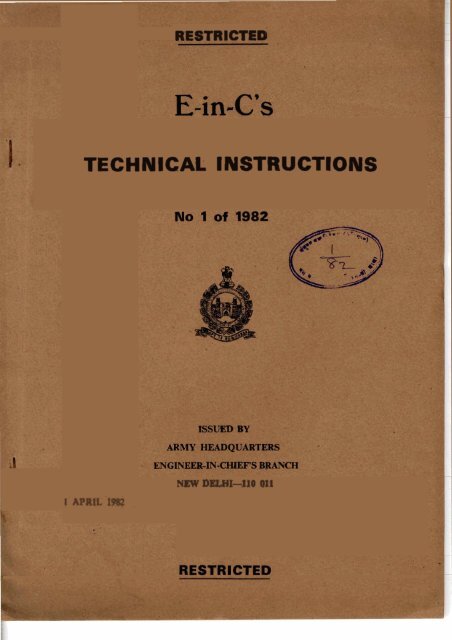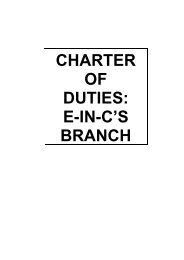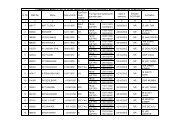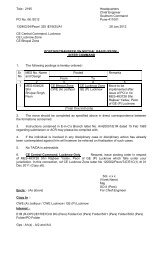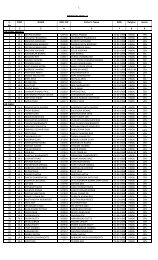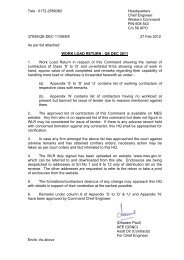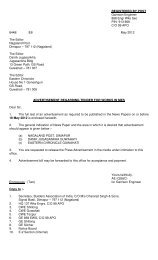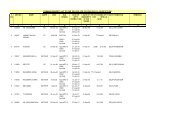Download Document
Download Document
Download Document
Create successful ePaper yourself
Turn your PDF publications into a flip-book with our unique Google optimized e-Paper software.
RESTRICTEDTECHNICAL INSTRUCTIONSNEW DWI-130m18 APRIL 'f981. ,
INSTRUCTION NO 1 OF 1982CQP~TRUC~ION IN LOAD BEARING WALLS0.1 Load bearing masonry walls/brick work is not new but suitably designedload bearing walls/br~ckwork is of comparatively recent origin. The first IndianStandard Code was issued in 196 1 and su bseq uen tl y revised in 1 %9 and I 980, :IS1905 of 1980 'Code of Pract ice for structural safety of buildings Masoniy walls'. Inthe past twenty years there has been emergence of modern struct uraI masonry formu1 tistoreyed construction in many countries. The development has beenbased on application of structural engineerin principles to design of masonrystructures, thus overcoming the limitations of ''K ule of thum by procedures./0.2 Basic advantage of masonry construction lies in the fact that in loadbearing construction masonry performs a variety of functions viz; sup flingloads, sub-dividing space, providing thermal and accoudic insulation, i% andweather protection etc., which in framed buildings have to be provided forseparately.0.3 In Western countries 12 to 20 storeyed well designed load bearingmasonry buildin s have been constructed having only 20 to, 4Ucm thick walls. PnIndia quality o f bricks manufactured are comparatively poor and maximumcrushing stren th generally is of order of 70 to 150 k cm*. In many Westerncountries bric f s of even medium quality have crus f ing strength 400 to 600kg/cm4. A few mechaniseil brick plants have since been set up at few laces in ourcountry and bricks af 150 to 250 kg/cmY strength are bein manu actured. ItkPshould now be possible in some parts of India to go in or 5 to 6 storeyedload bearing structures at costs 15 to 20 % less than RCC framed construction.I. Z The structural adequacy of masonry waIls depends upon a number offactors as under:-(a) Strength of masonry unit bricks or bIocks(b) Strength of mortar(c) Workmanship and method of bonding(d) Location of longitudinal and cross walls(e) Position and size of openings in the walls(0 Unsupported height and length of walls and slenderness ratio(g) Eccentricity in the bading(h) Combination of various loads to which walls are subjected..$; -, ,-. 8.1 These are generally of the following types:. - (a) Cornman burni cloy brickSpecifications are laid down in IS 1077of I976 'specifications for common burnt clay building bricks' (third re-
5. Mortar, 2, ..vision), Brk ks are classified as class 35,50,75,100,125,150,175,200,250,3O and 350 accordin to average compressive strength in kg f]cm9, Theseare further suklassi i! ed as of sub-class A or sub-class B. Brick of subclassA have srhooth rectangular faces with sharp edges and corners anduniformity of wlour. Bricks of sub-class B have slight distortion.(b) SIones (in reguIar sizes unifs)-- Detailed specifications' are given inIS 1 597 of 1967 Part I & I1 'Code of Practice for construction of stonemasonry*.(c) Sand lime bricks-IS 4139 of 1976 'Specifications for sandlime brick'classified as class 75, 100, 150, and 200 according to their average compressivestrength as for common burnt clay bricks.d) Concrete Blocks- Minimum average compressive strength speciked is 50 kdcmf as per IS 2185 of 1967 'specifications fbr hollow wmentconcrete block'. The IS Code is however, under revision and theblocks are being proposed to be divided into various grades dependingon their compresswe strength varying from 20 to 70 kg/cmS for HollowConcrete Blocks.(e) Precast slone masonry Block-Spi fications are laid down in CB RlData Sheet No 8 of building kchnlque series Sep 1977 and CBRI informationNote 1 of Sep 1978. Stone masonry blocks of 30x20x15cmnominal size using spalls of 12cm size and lean cement concrete ,mixof I : 5: 8 are made. The block should be compacted during casting byusing piate vibrator. The nominal length and height of the block iskept 30cm and 15 cm respectively but the breadth may be 2 h , t5cmor I0 cm according to thickness of wall. The 28 days compressivestrength of blocks with the above mix is 70 kg/cma. Theconcretemixproportion is to k suitably adjusted with available materialsto meet the required strength. This lock constructioniseconomical in areas where stones areabundance and ateconomical cost. Method of production of blocks and spwial precautionsto be taken and details of masonry construction are given inthe aforesaid data sheet No 8 and information note Na 1 issued byCentral Buildi3.1 Requirements of good mortar for masonry are strength, workability,water retentivity and low drying shrinkage, Mortars wu1d Be broadly dassifiedas cement mortars, lime mortars and cement-Iime rqortars. Main characteristicsare as under :(a) Cement Mortars-These consist of cement and sand varying inproportionsfrom 1:6 to 1:3. Mortars leaner than 1:btendto becomeharsh and unworkable and are prone to seggregation. Rich mortars thoughhaving good strength have high shrinkage and thus liable to cracking.Cb) Lime mortars-These consist of lime, sand and burnt clay/surkhiin the proportion 1 : 2 : 3. The main advantage of lime miortat lies intheir good workability, low shrinkage and better resistance againstrainpenetration. However strength is much less than that of cement mortar.(c) Cement: Lime mortars-These have good qualities of both &ment aswe11 as lime mortars i.e. good strength aIongwith good workability,-
.. -retentivity, freed~m from cracks and go~d resistape agahstram penetrqtion. Commonly adopted mixes are' 1 : 1 : 6,1:2 :9add 1 : 3 : 12BDetails of mortars for rnasonr are contained in IS 2250 of 1965 'Codeof Practice for preparation and use a masonry Mortars' and< IS 1625 of 1971'Code of Practice for preparation and use of lime mortars'. Strength of variousmortars are given .,.* T+ble 1 bclow :, ~ a ~ c I I .i&o~~a~ss~ve;(Cement, , . . , :-, I Lime Sur2 ,-r - .it.I.'~ -,1-STREN&~,(D$ . , -I MASONRY MORTARSMix4.g;' :i , , ,2u ana above0 3'nR 50 and above .-- i4"'2. 1 (. .I,, a ' - a .d!f+!3.3 Mortar strength shall i general be not &ter than that of masonry and. , I I . , f , I4.1 As a general rule, apart from strength of masonry units#d grade ofmmar, strength of masonry depends on the uniformity of sip .qnd shape ofunits. Units which are true in shape and size can be laid with 'ctsmparativelythinner joints, thereby resulting in hi&r stren h. For this reason, use of'A'grade.bricks givw masouy of higher stmn !?as compred to that with Bgrade, .bricks wen. though crushing strength of grade bricks may be same asthose af A g~ade. For simjlar reasons. ashlar st oqe masonry which uses muratelydressed and shaped stme blocks is much stpager (nearly double) 'th&coursed stone msnory. Znm-m in thickness of bed joints from 1 Ornm to 16mmd masguy b s pr@xirnat$y 25%. For kick masomy ywrkprovisionsmnpo IS 2212 of 1962 ' 8 o f e of Pxactlce for brick work' are to be folIow-ed. . Details of bond, bedding and jointing are laid down in thjs code. Poorworkmanshi may seriously impair .the strength of brick work and 'introdw,weakness w g ish rnw permi$ ,moisture pnetratjoa and other defects. Themain defects in w6rkmanship which impair the gtrenah of mlyqng arc asunder :- ' ,A?,- , /. , -toi4 -, . - .- + h -. -.:$a1 ~';,.>,*iifd;'(a) Use of dry bricu~ot properly s o w in wate.. ..JT~ .,Q c , ~ .
(c) Failure.tobed joints(d) Deviation from verticaI Plane or alignment i.2. out of plumb masonry.(e) Unfavourable curing conditions.Tolerances permissible in the masonry are given in table 2 below :TABLE 2 MAXIMUM PERMISSIBLE TOLERANCES IN MASONRYSI No. Item Tolerance(1) Deviation from the position shown onplan of any brickwork more than onestorey in height(2) Deviation from vertical within a storey 6mm per 3m height(3) Deviarion from vertical in the total height of .12.5mmbuilding.(4) Relative di spIacement between load bearing 6mmwalls in adjacent storeys intended tobe in vertical alignm,nt(3 Deviation from line in Plan6mm12.5.mm total12.5 mm total
9fig. r, ma wdl A .has very good mistance a inst a lateral load,B, offem little resistance to Ioad acticg in the p o~gitudinai direction. The deformations in the two cases we shown by dottd lines. Thelateral loads acting on the fa~ade of a building are transmitted through floors(which act as horizontal beams) to cross walls, which act as shear walls. Fromcross walls, loads are transmitted to the foundation. This act ion is illustratedin Fig. 2 & 3.5.3 Asaresultof laterdload,therewill~anincreaseofcompressivestress on the leeward side, and decrease of compressive stress on the wind-wardside, The cross wall is designed f ~ zero r tension, and permissible compressivestress. It will be of interest to note that a wall which is carrying greater vertioalload, will be,in a better position to resist lateral load than one which is lightlyloaded in the vertical direction. This feature should be kept in view while planningthe structure so as to obtain an economical design.5.4 A structure should have adequate stability along both the principalaxes. The so called 'cross wall' construction would not have much lateral resistancein the longitudinal direction. In case of high-rise buildings, it is desirableto adopt 'cellular or 'box type' construction as illustrated in Fig. 4.,6.1 Size,shapeand1~tionofopningsintheexternalwaIbhaveconsiderableinfluence on stability and magnitude of stresses dcz to lateral loads.This has been illustrated in Fig. 5.6.2 If the opening in longitudinal walIs are so 1-ted and portionsof thesewalls act as flanges to cross walls, the strength of the cross walls get considerablyincreased and structure becomes much mare stable, as will be. seen fromFig. 6. +6.3 In a load bearing wall the length of openings should be minimum possibleto aIIow more wall Iength to carry the loads. The more the openings, the lesswill be the effective wall area and the more will be the induced st-. As ageneral rule the length of openings in a Ioad bearing wall should not exceed 50 O/,of the total Iength of wall.(a) Walls--Slenderness ratio for a wall shall be the effective hei tdivided by the effective thickness or effective length divided by the e ectivethickness, whichever is less.(b) Column-Slenderness ratio for a column shall be the effective heightdivided by the corresponding laterd dimension (thickness or width),Forthepur seofdesign, higherofthe twovaluesis taken intoaccountsince the w P" umn can buckle in any direction.(c) Maximum slenderness ratio-For walls built in cement mortar& ame#41ime mortar, it shall not ,ad 27. When lime mQmr isused limits bf slenderness ratio shall be 13 and 20 for dewellingsacedin two storeys and not ex&h two storeys. respeetivdy* Fqrnon-loa d bearing walls like and wa f Is, c b W d s and. ppetwalk, slenderness mtio shd not ex@ 30. Parapet nd shallhowevbr be designed to be strong enough ta withstand' jaw1 forcesand other loads. For columns sIenderness ratio shall not exceed 12.w"%ICY \1;1- >.-. .- r'.,.!- - ,,,a i~ . . - .. '. L o --'.d?;~).:- ,L. .- : .--1-- - --_ --z .- L- -
1".-... .- - , .. -. b, ,6si ' 7 -. J ', . -,I,-. -- A%td:-@&&t#W-vekei#t&a watl ar cpoiumn &dl ba,thaschal height multi;pNed'byidd op rophate factop de ridiag n eud wndijtiom as given in table3 (Fig 7); S M P d y eEeaEive I&OL s- wxhdl be aotulll length mdwd byappropiate factor as per fable 4. Bht&w Wr @ 7 & 8.. I. .I .Table 3EPF'ECTJiVE HElBWW Fig 7.. 'Condition of supportI. I Walleffective .o .,. . heightI - " I , . .1, Adequate lateral support and partial rotaional mt- 0.75 Hraint at top and bottom-where the floor (or roof') hasa direction of span at right angles to the wdJ, srr &atthe reaction to the load of the floor or roof is rwihded by the walls or whtre the concrete floors aye w4 bearing on walls, irrespective of the dimtion of s@n.2. Adequate lateral support and partial rotational rest- 0.85 H #raint at either top or bottom, and lateral restraint at . I#other end. Fully braced construction which is itselfadequately supported and incorporates (a) timberfioors immediately below or above a reinforced concretefloor, (b) roof trusses above @I reinforced concretefloor or the like.S3. Ade uerta lateral support at top and bottom-wherethe oors (or roofs) have a direction of span parallelwith the wall, topand bottom, and do not bear on it:or fully braced construction which is itself adequatelysup orted and which incorporates roof trusses andtim r upper storey floors.&R1.00 H4. Adequate lateral support and partial rotational rest- I . 1.59 Hrainl at bottom and no lateral sup r~ OP rotationalrestraintatthetopwherethewdl g snolateralsup.. .ort at top construction not fully anchored or notF I, ully braced . I5. Free standing non-load bearing members. ' i & ~Table 4EFFECTIVE LENGTH OF THE ~hIISL @. CONDITIONS OF SUPPORT + I&&lpe ks@h 1
A f;2.,J.*,2S&rL Ia butt-or crass wa6.n)1 i& L= the :length s,s walls,, . *+,' , piers .*or buttress . d m ? ) ; ,. ,;. :%1. Eccentric loading affects the ufifoihd'stress on' one' side becomes more thanricity ratio reaches I/6 (for a 1.ecmngularzero and on the otherside compressive stress becomes twice the average valuei.e, the stress distribution block is a trlan@e. V ecantricity ratio exceeds 116,tension is .developed in one side. Since masonry is not expected !o take anytension a part of thickness of masonry member becomes ineffective. For economicaldesigns, therefore, eccentricity of loadi~g should he the least mb¬ completely avoided., -- hL. :.I ;.I (1 !Allowable compressive stress in the masoarymntric loads, . . .' D* consideratiom. .gets reduced with(4 ' 8:9.1 General-Load bring walls are structurally more efficient when the loadis uniformly distributed and when the eccentricity of loading on the wallis as small as possible. For ensuring uniformity of loading, openin@in walls should not b too large, bearings for lintels and bed bhks under'id-! :5-beams should be liberal in size, heavy concen tratim of loads should, beavoided. One of the commonly occuring causes of cracks in masonryis wide variation in stress in masonry in adjoiningcity 'of loading on walls s vi ~ ing a 'full * Ecccntri- ~ bearing - -of floors/rooton the wal&- *&&,-( : .,LA d.'1proc.&m. ;r, ,..:: t.: ,II '#iibuilding as a whole shall be analyd by accepted principles ofmechanics. All component parts of the structure shall be capable of~usbinhg the most adverse combination oflods whbh- may be reasonably expected to be subjected to during or a ftbC ter erection. blrildiog3wing constmotion the effects of wind, back fillins behind walls, or4th~ erection conditions shdl be so controlled that no adverse or unconditionsoccur in the masonry.
F III 'I9.3 h&mYllall.9.3.1 The thickness of a load bearing d 1 shall be sufficient at all points toensure that the stresses due ts worst conditions of loadin are withinI the limits prescribed for that rticular type of wali. e thicknksP"dused for design calculations sha 1 be the actual thickness of the masonry,not the nominal thickness. See Fig. 9. In masonry with raked joints,~'Ithe thickness shall be reduced by the depth of the raking out. See Fig 10.9J.2 However, if joints are raked to provide key for subsequent plaraking could be ignored. tf any face of a wdl is to be pointedesirable to do rnkin and pointing while the mortar is green toany loss of strength 'f ue to raking. For solid walls adequately binto piers or buttresses at intervals, the effective thickness shallactual thickness of solid wall multiplied by the appropriate stiffenincoeffici~nt iven in table 5 given below. For cavity walls, the c!rectivthickness s II be two-thirds of the sum of the actual thickness of thtwo leaves 8, El4 "STWFENNG COEFFICm FOR WALLS -'BYTMBSES/QR INTERSECTING WALLS. I' !,-.I. I. rd BUT-Ratio, - spIFFENING CQEFFIGIENT'p 'R 3 pr moreWP . -wmwm&rfsc w ,6 1 .O 1.4 .--**8 1 .O 1.3 - 1.7I0 1 .o 1.2 s.! 4 1.415 1 .O 1.1 1.220 or more 1 .O 1 .O 1 .OWheresp - centre to centre spacing of the pier or intersecting walltp = the thickness of piertw = eual thickness ofrwall oper; andwp = wldth of the pier in the i~ction of the wall or tk'e actuaI thickness of theintersectrng wall., Note:--' Linear interpolation between the values given In M a tabk is permissiblebut nat extrapolation outside rhe limit givec.In case of veneered walls, veneer shall not be ms;dered to be part ofthe wall when computing the strength or required thickness of thewall.-r10. f The gemiis~ible sive sir'&%% masonry depends upon the foHawingfactors:(a) Strength of masonry unitsb i
I,~B~E.=@F~,. - :I5 AI::!;..i:
Note-1wnear interpolation betwcen values fg the stress factors is pormissibb.',.: a -11d**il:p,\ai
II. -- ortar not weaker than? 1 :l: 6 wmcnt: lime: sand, the pmjssible tensile stress irt bending shouidn~i,y$cqd, I Pu@~ot.. 2' tk. , ;, - --- .,'. I.. . - rr'kil.,:t . 4L.6,3m tl; ) ! '-' I... r. .. I12. Pqm&dliiIt+&~'" -
Note92 Pot uunaidod mawpry, the .lafl in lPd are -foynipyses of, "interpolation ody. ....,. ,:'I i*i:rn 2 $ ~ , i:bt* i!!rlr; XL:..10.7.1 Addition strew8 d a p d y local naturc as at gi~W&h~11;.wiurnntbases9 lint& or other cmntrpd loads shalt be cal.cuhtd a d themaximum ~&ms wlting fid $7mmbingh ofstms&sw'th @her s shsll no# cad tb pmissiMe s -re thani itI , I $ r i a w ! r t . m d b . qdv,a %bf &sp&n d &e lading ss~lthe dirdm of raeh lopding.a I 4fhb' , , , !bt takes uair*rsb W 43 !R:..*gibe Gtile, strew of bricg -:j'-'qv j 4 1 . ~~.fl i~k'l I rdQiJ.(j ih'j}, 1 ;;i3Uk3.a In P~d1.1 :-.(j wo fM&atim,: 1 Th~gm &the. sectiw in knslons will bpt+hr.tl as$- to b&mctiwf@ them~ain&-will w,oompressive strev.)8& +I oa41cla b SW@ typto6.Wl Mwib stmep is &~dbg may be takgp


